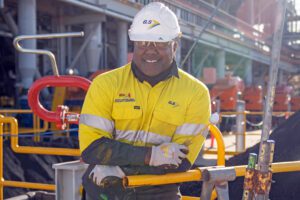Every now and then I meet people who claim that what is needed to improve safety is ‘strong and visible safety leadership’. I sort of get what they mean with ‘visible leadership’ (that leaders can be seen doing the right things), but the rest is confusing. Strong? How strong exactly? Strong in order to do what? What do you mean by ‘leadership’? And what do you mean by ‘safety’ anyway?
Further exploration of the idea of strong and visible safety leadership normally leads down a fairly predictable route. The usual suspects in expanding on the concept includes:
- The standard you walk by, is the standard you accept. This message needs to come from the top-down.
- We need leaders who make it clear to people where the line in the sand is.
- We need leaders who are ready to have the tough conversations about safety!
Put differently, ‘strong and visible leadership’ is a reactive and behavioural intervention, mediated by role modelling and the use of punishments (and rewards) to urge people to comply with the desired behaviours. It is based on assumptions that there are objective safe and unsafe behaviours and conditions (safety is bimodal); that safety is about managing deviations (negatives), that safety is threatened by people not respecting procedures and external standards (people are the problem), and that safety can be ensured if people adhered to external standards (safety is a bureaucratic accountability).
READ RELATED CONTENT
- Managers may be setting the wrong priorities
- West Australia release industry performance snapshot
- Health & safety consultant
This is effectively a transactional leadership style:
- leaders promote compliance by setting clear expectations, and using rewards and punishments in return for the favour/transgressions
- its focus is on existing rules and procedures (thinking inside the box), rather than being curious about creating a better future
This way, safety is managed as if it was a disconnected aspect from work – as if it was not an outcome or emergent property of how work was setup up and done. It will lock people into a reactive mode, in which safety can only be improved when there are deviations. Safety will this way become driven by deficits, threats and problem which will contribute to a tedious and negative culture, which never really makes anything better.
Furthermore, strong and visible safety leadership will contribute toward problems of adaptation. In a world with a fast paced technological change, increasingly globalised, with competitive pressures to do more with less, trying to overcome challenges by imposing solutions that were developed for yesterday’s needs, will inevitably hold back organisations that need to evolve and overcome.
Some leadership thinkers have suggested that Transformational leadership is a more sustainable way to achieve people’s commitment and buy-in (notably James MacGregor Burns). Transformational leadership is based on the idea that sustainable change can be achieved, not by rewards or punishment, but through engagement with people. By articulating a compelling vision and explaining its importance, people can internalise motivation to achieve the higher order needs and the mission of the organisation. Consequently, people can find an identity and internal drive to do the right things, and take actions to align both behaviours and the environment to achieve a particular vision. This way, leaders are also more likely to get trust, admiration and followers.
I sometimes find myself attracted to this type of leadership discourse. I like the idea of a more forward looking and intrinsically motivated style of safety leadership. But at second and third thought, I can’t see that it is much different from the strong and visible safety leadership talk. In this version too, it is the leader’s task to step forward, do the thinking and feeling, take charge, articulate a vision, and get people’s buy-in. Safety is still being managed as if it was a top-down hierarchical responsibility. The transformational leadership appears to have the same basic assumption: that people are a problem – that they need instructions and motivations from leaders to do what is right.
So, what would a leadership model à la safety differently look like? How can leaders engage based on the ideas that people are the solution, that safety is about a capability to create positive outcomes, and that safety is an ethical responsibility? I’d like to start a conversation about this by suggesting a number of necessary shifts:
From answers to questions
John Green’s post about curiosity highlights that traditional ways of managing safety are hinged on providing people with the right answers for how to do things. This way people don’t have to think for themselves (apart from when they have to, which is often pointed out after incidents). Furthermore, by constantly providing the answers we gradually lose the capability for conversations between people that can generate new answers and insights about how things get done.
Leading safety differently is about having the courage to not have the answers, but trusting that the answers are out there to be found. When leaders enter a situation there is an opportunity to pursue questions like:
- what is going on here?
- how do things get done?
- what is it that I don’t understand or know?
- what’s a mystery to me?
- what can I learn here?
These questions open up pathways to the unknown, the uncertain, and the unpredictable. Surprise is pretty much the only way to discover the distractions, difficulties, complexities, and other challenges that brew outside what’s in procedures. Unless we have pathways to surprise ourselves, not much is going to improve.
From reactive to creative
Every purposeful action comes with a risk of failure. It is hence the action or activity that gives rise to the need for safety, but also to the potential for success. This gives leaders two options. They can try to ensure safety by safeguarding people and processes so that things don’t go wrong – playing it not to lose, maintaining standards, keeping things in place. Or, they can enable safety by setting people and processes up for success. The difference is that the former leads to constraints and compliance to make sure that things don’t get out of hand. The tendency will be to map the present with standards and ideas developed for yesterday’s needs. In contrast, building capability to achieve successful outcomes uses the present to ask questions about what future can be created.
Leaders who want to do safety differently, are likely to ask:
- What is possible here/now?
- What haven’t we thought of?
- What ideas do people have for making things better?
From hero to host
Organisational charts with roles and responsibilities can be considered a chart over who has the power, who gets to set the standards and expectations, who is accountable to whom. But as Ron Gantt pointed out to me in a recent conversation, when it comes to safety, organisational charts are better understood as a distribution of labour. This means that all the positions of the chart fill different roles to enable the safe functioning of the workplace, and each position has a different view and can contribute in a different way.
Workplace problems are more often than not, complex problems, wicked problems, problems entangled and influenced by a wide range of sources. There is no single individual in any organisation who has the full understanding of every aspect of an issue. Strong and visible leadership is perhaps able to produce a temporary result in a specific area, but this way the underlying cluster of issues that gave rise to the problem in the first place will remain unaddressed.
To lead safety differently is to accept that in order to understand any issue the organisation needs input and involvement from many, most or all parts of the business. As Margaret Wheatley puts it: We need leaders who can host a platform where the different parts can come together and build a rich common understanding about what is going on, leaders who can give the time reflect on what is going on, and leaders who can deflect other leaders who wish to take control and be heroes.
To lead safety differently involves asking questions like:
- Who else should be involved in this conversation?
- What skills and insights of people are available to understand and address this issue?
This is not a warm and fuzzy approach. It is a more refined way of solving problems.
From constraint to facilitation
I am still to meet a person who is not motivated to be safe. People do not come to work to do a bad job, or to create incidents and accidents. Nevertheless, they sometimes end up in difficult situations which may lead to undesirable outcomes, design their own workarounds, or even breach procedures. But people don’t do this because they are bad people or thrill seekers. They do this to get things done, because they are passionate about the success for their team, supervisor and the organisations.
To lead safety differently is to assume that people already have the motivation to be safe. There is rarely, if ever, a need to motivate people further. The challenge is instead to facilitate for people to make informed decisions, to have adequate resources and tools available to meet demands, to address the conditions that undermine performance. The role of a safety leader is not to constrain people, but to facilitate work – so it can be safer, more efficient and more productive.
This too involves asking a different set of questions, or looking for different answers:
- what are people most dependent on to be successful?
- what makes their work difficult and challenging to perform?
This way organisations can harness the existing motivation and work with people to create better workplaces. Leading safety differently is not about ‘keeping people safe’. It’s about enabling people to carry out tasks successfully across varying conditions.
Weak and invisible safety leadership?
The above suggestions are not intended as a set of new norms that leaders should follow. That would be an ironic error on my part. What I’ve tried to do is to point out, and start a conversation about, how leadership can be understood in a safety differently context. Using this lens highlights new ways for leaders to see and be in relation to creating successful workplaces. Primarily, I’ve pointed out that leadership is not the end, but a means. And if the goal is to create stronger, better, smarter, more innovative organisations, the role of the leader can probably be better executed in more of a background role. Not invisible, but in a way that supports people.
Now, the above is in contrast with the idea about strong leadership idea described earlier. But I do not think that the suggestions above can be described as weak leadership. The way I see it is that this kind of leadership would require greater courage and greater strengths on the leader’s part – to be behind the scenes, to not have the answers, to not claim credit for success. And in all likelihood, an organisation made up from people who are supported and given latitude to have input and take responsibility will be stronger than one in which people are driven by either punishment or rewards, all things being equal. In a safety differently, context, what is needed is a strengthening leadership, rather than strong leadership.
By Daniel Hummerdal
Read more Mining Safety News and Articles














100% agree Daniel, you are one of the thought-leaders in this space. This will be a huge leap for the mining industry but not impossible. This industry has compliance obsession and the more bad outcomes we see, the more compliance it seeks. Governments increasing penalties is not helping. Control and constraint, binary thinking and a blame and punish mentally is very deeply entrenched at every level.
It will take a very thoughtful and deliberate approach to avoid the pitfalls of every other intervention that the industry has adopted in the name of health and safety over the last 30 years, just look at the abject failures of BBS and the more recent mindfulness brigade hawking silver bullet solutions.
The ‘new view’ requires a major shift in current thinking and a long-term approach.